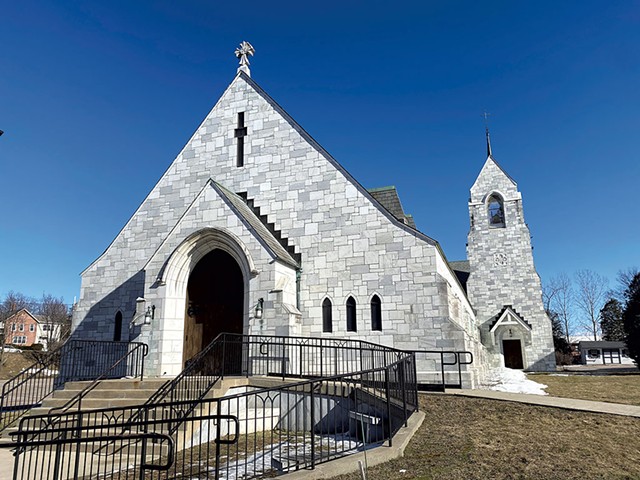
- Sasha Goldstein
- St. Stephen Catholic Church in Winooski
St. Stephen Catholic Church, constructed from marble quarried in Rutland County, is an eye-catching Winooski landmark. With its Gothic Revival touches, the 95-year-old church is one of four designed by the Boston ecclesiastical architectural firm Maginnis & Walsh, and it commands a block not far from downtown.
The question is: for how much longer? Plans to demolish the structure this spring have forced church officials to explain to upset residents why they would rather swing the wrecking ball than convert the building for nonreligious use.
The church, which closed in 2020 due to a priest shortage, has sat idle for the past two years. Its assets were transferred to St. Francis Xavier Parish half a mile away, and a sale contract is pending with Sisters and Brothers Investment Group, which plans to build housing on the old church's site. The Roman Catholic Diocese of Burlington has since filed an application with the city to demolish the church, out of concern that the building might otherwise be used for unholy purposes someday.
"The parish council voted to raze the church building as the best way to honor its sacred character," Rev. Yvon Royer, pastor of St. Francis Xavier, explained in the church's demolition application. He warned against "future litigation" should the building be used for anything "unbecoming, immoral, or even offensive to Catholics."
Some Winooski residents, in online comments, took sharp aim at the church's reasoning. "God does not live there," one snapped on Front Porch Forum. "It is simply a building now — NOT a church," another chimed in.
"The loss is sort of like a gut punch," said Britta Fenniman Tonn, a Winooski resident and architectural historian. Tonn helped write a letter in opposition to the demolition permit that received over 80 signatures from community members. A public hearing on the appeal is scheduled for Thursday, February 16.
Church closings are hardly new in Vermont, which is regularly ranked as the least religious state in the country. Church attendance, already sagging, fell further as houses of worship went remote during the pandemic. A 30 to 50 percent nationwide decline in attendance has continued even after church doors were flung open again.
That trend has added urgency to the question of what to do with underutilized church spaces, a delicate calculation that can inject themes of spiritual significance and sacredness into the earthly decision making around whether — and how — to repurpose a brick-and-mortar building.
Ben Doyle, president of the Preservation Trust of Vermont, has noticed an uptick in churches for sale across Vermont during the past decade. He said the buildings, which often feature large, open spaces, are ideal candidates for new uses. But Doyle said the diocese, which owns many churches in the state, has been inconsistent in how it approaches whether to transfer buildings to secular use — a process known as deconsecration — or to demolish them. "I think it's often related to the value of the real estate under consideration," Doyle said.
Monsignor John McDermott, of the Roman Catholic Diocese of Burlington, said it's up to each parish to decide what to do with the assets when it closes. In some cases, he explained, demolishing a building is simply more cost-effective than selling it.
Deconsecration mostly involves the removal of things: the objects used in communion, relics of the saints and the altar stone. Beyond that, there's not much guidance. Erica Andrus, senior lecturer in the University of Vermont's religion department, noted the difference between the Protestant and Catholic conceptions of sacrality and their influence on deconsecration. For Protestants, she said, things are not so much imbued with holiness as are people. In Catholicism, though, items, such as the bread and wine employed in the Eucharist, are made holy through prayer.
These differences can produce varied results when it comes to finding new purposes for old churches. Last month, the diocese received permission to demolish the Cathedral of the Immaculate Conception, which closed in 2018 and occupies a prime piece of real estate in downtown Burlington. The decision was a blow to preservationists, who say the site is one of few in Vermont that employs a modernist style in both building design and landscaping.
But Monsignor Peter Routhier, rector of the Cathedral of St. Joseph, defended the decision as a way to prevent a "problematic" repurposing of the building. "Especially if it was an art venue, because the art world, the plays that could be put on, the things that would be said, would be so abhorrent to Catholic faith and tradition that it would be appalling," he said last month.
Nonetheless, plenty of Catholic churches across the state have been converted for new uses, including as art venues. GreenTARA, an art gallery, coffee shop and studio space in North Hero, was once a Catholic church. Before that, it was a general store.
Owner and architect Diane Elliott Gayer fell in love with the building when she first saw it 10 years ago. It took her more than three years to convince St. Benedict Labre Church to sell. Church officials were worried about what art she might show and what it might say about the Catholic religion. "They're worried about today's art?" Elliott Gayer asked. "They should look at their own heritage."
Elliott Gayer's only concession to matters spiritual was to hire a geomancer, someone who claims to use divination to interpret patterns on the ground. ("To clear the energy spirits," she said.) The geomancer's verdict? Spiritually sound.
Elliott Gayer said the building works well as a gallery. The huge space is configured in a way that forces viewers to focus on the art in front of them.
Elsewhere around the state, former Catholic churches are housing a wide variety of enterprises. In Websterville, a mixed martial arts studio operates in an old church. In Eden, a church has been repurposed to be a hardware store. And in Saxtons River, the former St. Edmund of Canterbury is now a live-and-work space.
"We're onto our third church," Clark Hinsdale, vice chair of the Ferrisburgh Selectboard, said with a chuckle. The town hall and grange hall are both former churches, one Catholic and the other Unitarian. In January, the North Ferrisburgh United Methodist Church, citing dwindling congregation numbers, donated its building to the town. Hinsdale said it has worked well to have a town hall that was once a church, because it accommodates crowds.
Former churches can be ideal spaces for addressing pressing needs in rural towns: Hinsdale said one idea for the old Methodist church is to turn it into a childcare center.
"When a church closes, it leaves so much that needs to be filled," said Bebe Bullock, vice president of the board of directors for the Arlington Common, a nonprofit enterprise that is housed in the former St. Margaret Mary Church, which sits in the center of Arlington. The board purchased the property in 2021, with terms of agreement specifying that "nothing lewd" take place in the building.
The church and surrounding buildings are being transformed into a concert hall, fitness facility, café and educational center — all things townspeople had identified as missing in the community.
In the meantime, since its soft opening in 2021, the Arlington Common has hosted yoga classes, concert series and even fly-fishing festivals. "All of a sudden, it became everybody's place," Bullock said.
Bullock told Seven Days that a number of former members of St. Margaret Mary Church have told her that it has been healing to continue using the space, even if for a new purpose.
David Mangan has had a similar experience. He recently purchased a retired Roman Catholic church in Marshfield to expand his family's pie-making enterprise, known as Red Door Bakery.
"The first time in the building was sad," Mangan remembered. "It's like going to an old house and you see the old dreams and loves of who lived there, and now it's just sitting there." But former members of the church expressed gratitude for finding a use for the building, Mangan said. He likes having so much space for his commercial cooking equipment.

- Steve Legge
- Dirt Church Brewing in East Haven
Some churches have been repurposed for uses that might seem less pious. Take Dirt Church in East Haven, a brewery and art gallery in a historic Methodist church. Owners Bruce Lindsay and Anna Cronin purchased the property in 2019 to make good on their "10-year plan" to open a brewery. That became a "10-month plan" when the pandemic hit.
"Dirt Church is like the anti-church," Cronin said, laughing. In a sense, though, the space serves much the same purpose it did a century ago, as a gathering place for a small community. "What really spoke to us was the timelessness of the fact that the church was a cultural and social center for every town in New England," Cronin said. Now, patrons of Dirt Church raise pints instead of the Bible.
The Preservation Trust of Vermont holds "sacred space" retreats each summer to help steer spiritual leaders in the complex, and often sensitive, work of transforming their religious spaces into secular ones. "I think so many people care about these buildings, even if it's not a building that was historically aligned with their individual faith," Doyle said.
That's one argument that Winooski residents are presenting to the zoning commission tasked with hearing their appeal against demolishing St. Stephen. Dozens of residents have expressed their support for the building, which they say is central to Winooski's character.
"If we could go forward 50 years from now, no one is going to regret saving that building," Doyle said. "We only regret losing them."














Comments
Comments are closed.
From 2014-2020, Seven Days allowed readers to comment on all stories posted on our website. While we've appreciated the suggestions and insights, right now Seven Days is prioritizing our core mission — producing high-quality, responsible local journalism — over moderating online debates between readers.
To criticize, correct or praise our reporting, please send us a letter to the editor or send us a tip. We’ll check it out and report the results.
Online comments may return when we have better tech tools for managing them. Thanks for reading.